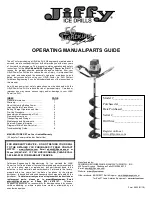
CircuPool
Help Guides:
RJ Classic Series
4
BASIC WATER CHEMISTRY - PHOSPHATES & NITRATES
Phosphates are a part of the environment:
Phosphates became a household word in the 1970's. This is when people started to use
low-phosphate and phosphate-free laundry detergents to help minimize the detrimental effects of excess phosphates in lakes,
streams, wetlands and other runoff areas- effects such as unwanted algae blooms.
Phosphates accumulate in pools:
What's true for lakes is also true for swimming pools; there are innumerable ways phosphates can
get into your pool. Phosphates are a natural component of most swimmer wastes. It is also present in rain water. It can be blown in
on the wind, in dirt or dust, or in plant material that enters the pool. It may also be introduced by landscaper's fertilizers at very
high levels, which may blow into the pool or come in from water runoff. Phosphate levels are persistent and do not break down
naturally- you have to treat the water to remove phosphates. For all of these reasons, pools can quickly build up phosphate levels.
This can lower chlorine levels and create an abundant source for all strains of algae & microorganisms, and can make controlling
their growth difficult. Remove the food source, and you can normalize chlorine demand and have a strong weapon against algae.
When phosphates are present, chlorine levels go down and algae grows:
Phosphate is the main ingredient in fertilizer. Phosphate is
plant food, and algae are plants. If you have had persistent trouble with chlorine levels or algae, you may have a phosphate problem
in your pool. When excess phosphate is present in a swimming pool, the symptoms often include the following: Quickly Dissipating
Chlorine Levels or Excessive Chemical Consumption; Cloudy, Green Water; Slippery and Slimy Surfaces; Mustard and Green Colored
Debris; Poor Water Quality.
Remove the phosphates and solve the problem:
It only takes tiny amounts of phosphates to become significant in pools. The
maximum level of phosphate in pool water should be less than 100 ppb, as close to 0 as possible. Once the phosphates climbs above
this level, the water quality begins to decrease. Fortunately, draining to eliminate the accumulated phosphate is no longer
necessary. Phosphate removers can be added which allow the phosphates to be removed from the water. A popular choice is
Natural Chemistry's Phos-Free, which is a natural mineral product and is non-toxic.
You can test for phosphates in your pool with the AquaChek Phosphate Test Kit found at www.aquachek.com
Nitrates:
Nitrates are a matter similar to Phosphates, but of different origin; however both a food source for algae. Nitrate is a plant
nutrient and is present in all green plants and fertilizers. It is natural occurring and is found everywhere something is growing.
Nitrites (NO2) are a close cousin to Nitrates (NO3) and are just as much of a problem for pools, because when a Nitrite comes in
contact with water, it easily gains another Oxygen atom to become a Nitrate. This additional atom gives Nitrates real stability, and
makes eradication difficult. In fact, the only known way of Nitrate removal in pools practiced today is to drain a portion of the pool,
and refill with water that is Nitrate free, if possible. Shocking a pool heavily will revert the Nitrates back to Nitrites, but can easily
revert once again as an additional Oxygen atom is easy to come by in a swimming pool filled with H2O.
Where do Nitrates come from?
Rural areas - those with water wells and septic tanks are particularly prone to Nitrate contamination
in pools. Fertilizer is the most common source of Nitrates in pools. Animals that enter the pool, as well as birds spend time above the
pool, can become a significant source of contaminants. Rain spilling off of overhanging trees can add Nitrates to a pool, and even
acid rain itself, so common in the Northeast, can increase Nitrate levels. Finally, human waste, sweat, cosmetics can all bring traces
of Nitrates into the pool. At levels as low as 10ppm of Nitrate, algae will grow even though you have used algaecide and are keeping
a proper chlorine residual. But keeping a proper residual of chlorine in the water can prove to be difficult when Nitrates are present.
This is what tricks people into believing in Chlorine Lock- it's not blocking chlorine, but using it very quickly.
What can be done to Eliminate Nitrates in my pool?
There still however is no chemical to remove the Nitrates from the pool water,
so if you have a contamination, you will need to drain most if not all of the pool water.
Содержание RJ Classic Series
Страница 14: ...CircuPool Help Guides RJ Classic Series 14 Examples of GOOD titanium plates...
Страница 15: ...CircuPool Help Guides RJ Classic Series 15 Examples of DAMAGED titanium plates...
Страница 16: ...CircuPool Help Guides RJ Classic Series 16 Examples of DAMAGED titanium plates continued...





































